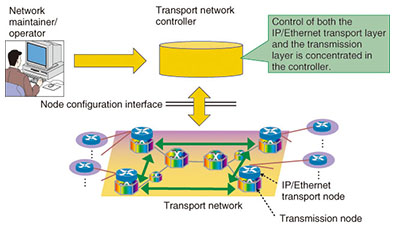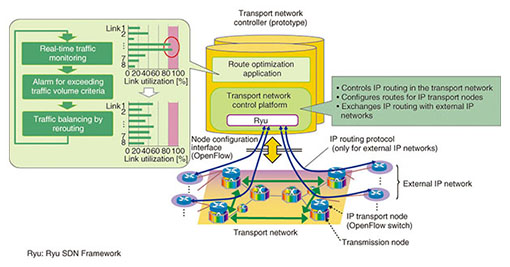 |
|||||
|
|
|||||
|
Feature Articles: Technological Development for Network Virtualization Vol. 12, No. 8, pp. 11–17, Aug. 2014. https://doi.org/10.53829/ntr201408fa3 Network Virtualization Technology for Implementing Future NetworksAbstractNTT Network Service Systems Laboratories has been applying network virtualization technologies such as NFV (network functions virtualisation) and SDN (software-defined networking) as part of efforts to develop the architecture of future networks that are efficient, flexible, and intelligent. This article gives an overview of these efforts. Keywords: orchestration, open innovation, transport network simplification 1. IntroductionAnticipation has been increasing recently for the application of network virtualization technologies such as network functions virtualisation* (NFV) and software-defined networking (SDN) in carrier networks. NTT laboratories have been carrying out research and development (R&D) aiming to achieve innovations in network structures and development schemes by applying virtualization technologies. The objectives are to: (1) centralize service and management functions in the cloud; (2) simplify transport equipment and integrate layer processing; (3) use orchestration functions to automate operations and reduce operations expenses (OPEX); and (4) promote open innovation with global cooperation among carriers and vendors, as shown in Fig. 1.
NTT Network Service Systems Laboratories has been conducting R&D focused on implementing the architecture of future networks based on these technology trends. We introduce three such initiatives in this article. The first is to implement orchestration functionality to handle virtual networks; the second is to establish new server platform technologies through co-innovation and promotion of open innovation; and the third is to develop centralized transport network control technology to simplify transport networks.
2. Operations suitable for network virtualizationWith virtualized networks, equipment design can be carried out for all resources, rather than for individual, dedicated hardware, so reductions in design and construction work can be expected through economies of scale. Also, general-purpose standby servers can be allocated flexibly to the services experiencing faults, so it is no longer necessary to have standby equipment for each type of dedicated hardware, and there are fewer faults that require urgent attention. In these ways, network virtualization can lead to reductions in OPEX (Fig. 2).
We have been studying ways to automate virtual network operations (adding equipment, initiating fault recovery, etc.) more than ever before using orchestration functionality. Specifically, we have been examining functions that detect when set thresholds are exceeded and automatically add resources, functions that detect faults and automatically recover from them, and other functions. We aim to achieve dramatic reductions in OPEX through the following orchestration technologies (Fig. 3).
2.1 Optimized resource allocation technologyWhen general-purpose servers are allocated in order to add resources or enable fault recovery, the resources used on each server must be equalized, and resources must be allocated according to service requirements (reliability, delay, etc.). Our goal is to establish optimized resource allocation technology that makes it possible to set and control multiple policies related to allocation, including (1) selecting servers in geographically separate locations when allocating active and standby servers for services requiring reliability and (2) selecting servers by location so that any network delay that occurs is equivalent between active and standby servers (for applications that are affected by delay). 2.2 Fault source inference technologyVirtual networks are implemented using multiple layers (virtual servers, physical servers, virtual networks, physical networks), which makes administering the configuration and determining the state of equipment rather complex. The goal of fault source inference technology is to infer the location of a fault when a fault occurs by combining alarms and other information from each layer, and to use it to speed up fault recovery. 3. Server platform technologies supporting service provisionA lot of research has been done recently on virtualization of network functions using NFV, including software implementations of service application functionality on communication networks. Here, we describe initiatives to implement new server architectures that will enable rapid provision of such service applications. Conventionally, communication network advances have been driven by developments in hardware, switching, and data processing technology. Software has been developed and communication services provided that satisfy quality and reliability requirements over a diversity of network devices. Consequently, selecting hardware and middleware for each network device, achieving reliability and extensibility with service applications on each device, developing service applications, and building equipment and maintenance systems have consumed an enormous amount of time. As the services provided on communication networks become more diverse, and as network functions are increasingly implemented in software on future networks, we expect that the types and numbers of network devices will increase further, and increasing numbers of service applications will be developed, so it is important to resolve this issue. NTT Network Service Systems Laboratories has proposed new server architecture as a common distributed processing platform. This architecture maximizes the common components of communication network functionality and is designed to be built using only the required number of general-purpose hardware devices by using virtualization technologies, and to realize the reliability, extensibility, and operability cultivated by communication providers and their partner companies (Fig. 4). By using this architecture, network operators and service providers can focus on the functional logic of their service applications and implement them on the network quickly and efficiently.
NTT laboratories and our partner companies have cooperated from the conceptual stages in order to realize this server architecture. We have utilized our respective strengths and promoted co-innovation through collaborative research (Fig. 5). In this collaborative research, we aim to refine technologies for distributed processing, virtualization, and maintenance and operations from multi-faceted perspectives of the three corporations, and to create technology through synergistic effects. NTT laboratories are providing the distributed processing technology (the engine component) related to carrier server requirements, scale-out capabilities, and redundant configurations. This technology enables system performance to be increased in proportion to the number of general-purpose servers comprising the system. It also distributes load appropriately across multiple servers and controls the backup servers that load is assigned to when hardware faults occur. Our partner companies are providing system requirements based on global markets, server virtualization technology, orchestration technology, the distributed processing system technology (the core software development capabilities), and maintenance and operations technology.
In this way, we aim to establish new server architectures that will enable service applications to be developed quickly and to develop technologies that will provide support in fields beyond future communications networks (such as finance and medicine) that require the results of this research: reliability, extensibility, and operability. By advancing the level of sophistication, we also aim to promote these technologies globally and to create global standards. 4. Centralized transport control technology to simplify transport networksThe capacity of transport networks must continually be increased in order to handle the communication traffic that increases each year, mainly due to Internet traffic. A major issue for telecommunications carriers in such conditions is the need to achieve dramatic reductions in transport network equipment and maintenance costs. Telecommunications carrier transport networks generally build a transport layer using technologies such as Internet protocol (IP) and Ethernet for flexible transport; that layer is on top of a transmission layer that economically handles long-distance transport through the use of high-capacity optical-wavelength or packet-transport paths. To substantially reduce costs in transport networks, it is important to simplify them by re-examining the implementation of functionality within the transport and transmission layers. Next, we describe centralized transport control technology, which can reduce equipment costs when used in combination with another technique such as substituting high-capacity optical transmission nodes for transport nodes or integrating transmission and transport layer equipment. A transport network architecture that uses centralized transport control is shown in Fig. 6. A transport network controller (controller) is placed on the transport network, and the control of the IP and Ethernet transport layer and the transmission layer is centralized in this controller. Centralized transport control technology is a network virtualization technology that separates the control plane and the data plane for the transmission and transport layers, which facilitates control that spans these layers. There are two objectives in using this technology: (1) Reducing operational costs by providing a single interface for maintenance and operations of the transmission and transport layers. (2) Reducing the maintenance time and operational costs required to update functionality of transport and transmission layer transport network control (path and bandwidth control, etc.) when extending service layer functionality.
NTT Network Service Systems Laboratories has prototyped a controller that controls IP routes centrally without using the IP routing protocols that perform distributed IP route control autonomously between routers. This prototype was designed in order to evaluate the feasibility of applying centralized transport control technology to the IP layer. This prototype uses the Ryu SDN Framework [1] open source software developed by NTT laboratories. It implements an architecture that enables various add-on functionalities to be flexibly combined on a common platform that performs basic IP route control functions. A demonstration of the concept using this prototype was given at the NTT R&D Forum 2014, held in February 2014. The configuration for the concept demonstration is shown in Fig. 7. The prototype demonstrated the feasibility of centralized IP route control by combining controls to reroute faulty links and select optimized routes in order to equalize traffic volumes based on real traffic measurements.
5. Future developmentsIn this article, we have introduced some of our virtualization technology initiatives at NTT Network Service Systems Laboratories. We will continue to develop and actively promote various technologies for implementing the architectures of future networks. Reference
|
|||||



















